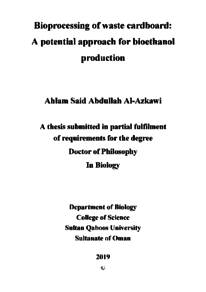Document
Bioprocessing of waste cardboard: A potential approach for bioethanol production
Publisher
Sultan Qaboos University
Gregorian
2019
Language
English
English abstract
The world energy demand is dramatically growing, mainly in response to increasing development and rapidly growing human population. Depending on conventional fossil fuel is no longer secure besides the environmental issues related to air pollution and carbon dioxide emissions. This has led to searching for other energy sources that can resolve above problems. Bioethanol is considered a possible substitute that can be produced from lignocellulosic materials like agricultural wastes and waste paper. The cellulosic content in the waste paper can be hydrolyzed to simple sugars by chemical and biological means. This work is focusing on the biological means by utilizing cellulase enzyme produced by microorganisms during their growth on cellulosic substrates. Enzyme cost is considered as one of the main challenges in the bioconversion of lignocellulosic waste. Therefore, the challenge is to achieve efficient bioconversion with minimal cost which could be attained by exploring more cellulase producers and utilizing cheaper carbon source in cellulase production. In this work, the screening study has reported approximately 100 bacterial isolates with cellulytic activity and the best two were identified by 16S rRNA to Bacillus subtilis S1 and Acinetobater pitti and were further tested on waste paper. Waste paper could be a potential carbon source for bacterial growth and cellulase production as it consists of 40-80% cellulose. The bioconversion of waste paper particularly cardboard into sugars for ethanol fermentation is the main focus of this work. Previous studies have mainly utilized office paper and/or newspaper as substrate for bio products or biofuel production while very few have explored the cardboard. Cardboard waste is one of the major components of waste paper in Oman, so it's a cheaply available carbon source. In this study, cardboard (CB) was found to contain 55% of cellulose and hemicellulose and has proved to be a suitable carbon source for cellulase production using the wild soil bacterial isolate, B. subtilis S1. An optimum cellulase activity of 4.20 FPU/mL was achieved using the response surface model with the optimized conditions. Hydrolysis of 10% untreated shredded cardboard by the crude cellulase from B. subtilis S1 has revealed maximum glucose concentration of 6.21 g/L which upon 24h fermentation produced 2.57 g/L ethanol corresponding to an ethanol yield of 0.41 g ethanol/g sugar with a volumetric productivity of 0.11 g ethanol/L/h. Better sugar yield was achieved using commercial cellulases and treatment with triton-X 100 had a great advantage in hydrolysis of shredded cardboard without any pre-treatment. Maximum saccharification of 99.4 % was achieved after 7 days of hydrolysis using 5% CB producing 30.4 g/L sugar with glucose and xylose content of 28.08 and 3.10 g/L respectively. Increasing CB load to 7 and 10% has slightly increased the sugar yield to 35.56 and 33.06 g/L respectively but reduced the saccharification to 83.1 and 54.1%. Production of ethanol was achieved via separate hydrolysis and fermentation (SHF) and simultaneous saccharification and fermentation (SSF) with batch and fed batch approach. Highest ethanol achieved via SHF was 11.08 g/L from 30.11 g/L glucose corresponding to an ethanol yield of 0.37 g ethanol/g sugar with a volumetric productivity of 0.23 g ethanol/L/h. In SSF approach with batch operation, 32.53 g/L with 146 % yield of ethanol was obtained and for fed batch operation using 50% of the usual cellulase load, ethanol
vii
concentration was 30.92 g/L with 139 % yield. Thus, ethanol production via fed batch SSF is method of choice in bioethanol production from waste CB. The advantage added in this study was the treatment of CB by triton-X 100 with no additional acid pre-treatment required and that has further enhanced the hydrolysis and fermentation rendering the process more economical. Up-scaling experiments are further required for successful implementation at commercial scale in "biorefineries".
Description
Thesis
Member of
Resource URL
Category
Theses and Dissertations

